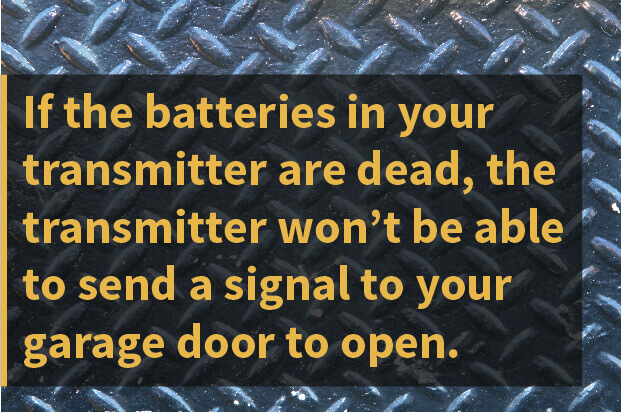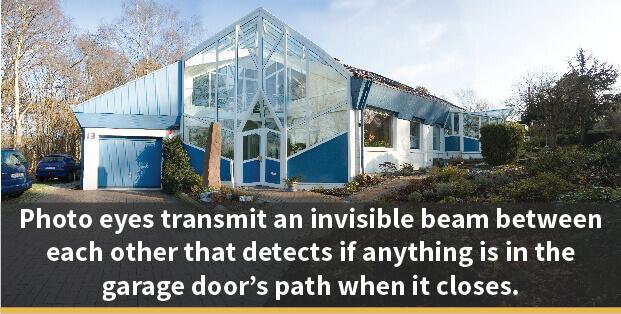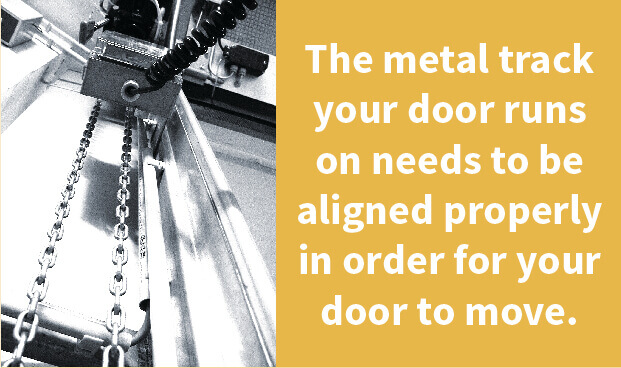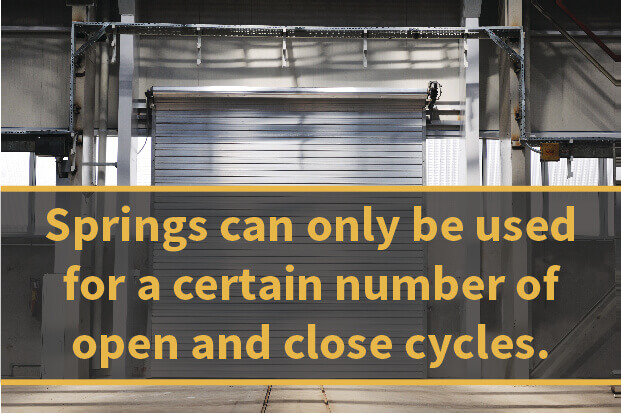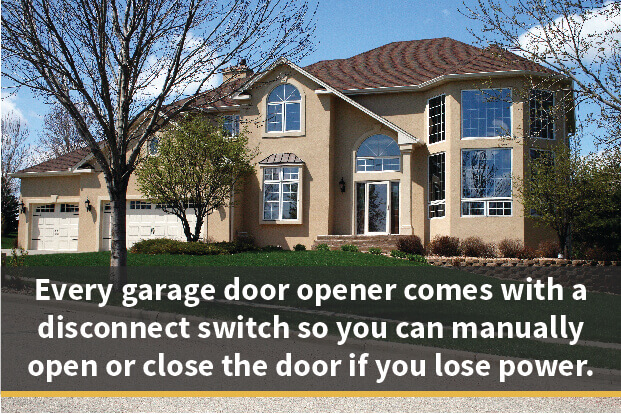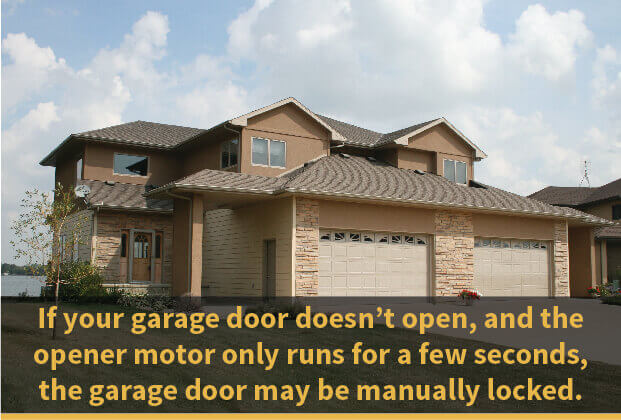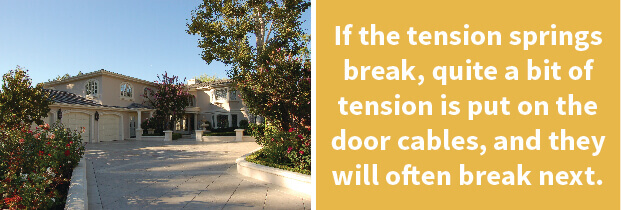Cleaning and Lubricating Your Garage Door Hinges, Rollers and Track
Your garage door just like any other mechanical device requires regular maintenance to perform its best day-in and day-out. This includes cleaning and lubricating your garage door hinges, rollers and track on an annual basis.
Cleaning your garage door track is the first step. Don’t use water or other chemicals as this can cause build up and do more damage than good. Instead, use a broom to brush off any dust and debris. Be particularly careful to clean out spider webs and other insect nests that might capture other dirt and particles that can clog up the tracks and wheels.
For garage doors in North Carolina, consider doing this seasonally after the brown pine pollen has finished covering the ground. In other areas, the spring is a good time to do maintenance because winter vehicle traffic brings an abundance of dirt and grime into the garage.
Once you have cleaned the track and other elements, the next step is lubrication. Lubricating your garage door hinges, rollers and track should be done with a light coating of spray silicon lubricant. You don’t need to apply very much and you shouldn’t apply liquid lubricants as this can also cause build up and collect other debris.
If you decide that you do need a garage door service professional to help with fixing your garage door or to do maintenance, or even give you a quote on a new garage door, we hope you’ll contact Custom Door & Gate your first call.
Testing the Reversing Mechanism of Your Garage Door
Garage doors are safety hazards, plain and simply. Because of their significant weight and proximity in the home, the chances of injury from crushing are very real. That is why automatic garage door openers manufactured after January 1, 1993, are required by federal law to have an integrated reversing mechanism and a photo eye sensor to prevent entrapment. This important safety feature senses when there is something in the path of the door. It stops the door and then reverses it. This protects you, your family or your car from accidental injury or damage.
Regularly testing the reversing mechanism of your garage door is a smart practice.
Despite this regulation, nearly 20,000 garage door related injuries are reported to the Consumer Product Safety Commission each year. Many of them are preventable by these safety features. However, they only work if your safety features are configured correctly. And testing the reversing mechanism of your garage door is the only way to ensure that this important safety feature is working. If your opener does not have this feature, you should replace the equipment.
Time for a test…
To test the reversing mechanism of your garage door, place a brick or piece of wood on the floor in the path of your garage door. Try to place this object as close to the center of the garage door opening to avoid causing balance issues.
When you push your garage door opener’s transmitter or wall button to close the door, it should strike this object and automatically reopen. If this does not happen, you should replace your opener or have the door serviced by a trained technician.
If you decide that you do need a garage door service professional, or even a new garage door, we hope you’ll Contact Custom Door & Gate.
Extending the Life of Your Garage Door
If you’ve ever been woken up by your garage door going up or down, you know how irritating it can be. The thunder of wheels rolling down their tracks or the high pitch squeal of the gears straining to lift the weight of the door are not just symptoms that something is wrong with your door, but also that you have a safety issue.
Extending the life of your garage door doesn’t have to be difficult or expensive. With the right guidance, you can do many things yourself. And as with most things, the best way to make it last is to avoid any series problems by doing a regular inspection of parts and performing minor maintenance as needed. Here are few things you can test to see if you’re garage door needs attention.
- Performing a Visual Inspection of Your Garage Door
- Checking the Balance of Your Garage Door
- Testing the Reversing Mechanism of Your Garage Door
- Cleaning and Inspecting a Garage Door Photo Eye
- Lubricating Your Garage Door Hinges, Rollers and Track
By performing these simply steps, you can significantly extend the life of your garage door, improve its performance and even save money by avoiding expensive repairs and reduced heating and cooling bills. If you do find a problem, check out our blog entry entitled, “A Guide for Fixing Your Garage Door” with helpful tips on what you should and shouldn’t attempt to fix yourself. And if you decide that maybe you do need a garage door service professional, or even a new garage door, we hope you’ll Contact Custom Door & Gate.
The Top 10 Reasons Your Garage Door Won’t Work
As commercial and residential garage door service professionals, we’ve pretty much dealt with every issue you can think of when it comes to garage door repair. Even still, there are sometimes issues that continue to surprise us, like the tiny insect nest growing on the photo eye sensor or the tennis ball that somehow managed to knock the door entirely off its track. Even though these issues are uncommon, it’s nothing that garage door service professionals like us can’t handle!
While there are times you may be able to fix the problem yourself, there are many reasons it may be best to leave the garage door repair up to the professionals. Knowing what’s wrong with your garage door may help you to determine if it is a problem you can tackle or if it’s time to call someone for assistance. To help you troubleshoot your garage door issues, here are the top 10 reasons your garage door won’t work.
1. The Transmitter Batteries Are Dead
This may sound obvious, but your garage door transmitters need power to work. If the batteries in your transmitter are dead, the transmitter won’t be able to send a signal to your garage door to open.
First, check to see if the transmitter on the wall inside your garage still opens your garage door when pressed. If it does, then the transmitter in your car likely just needs a simple battery replacement. If you have more than one car transmitter for your garage door, then your other transmitters will likely need new batteries soon as well, since they were probably installed around the same time.
Changing the battery on your garage door transmitter is pretty simple. On most, you can simply slide the door open on the back of the transmitter and remove the battery. Others may be screwed in to keep the battery more secure, so this type of transmitter will require a screwdriver to open.
After removing the old batteries, make sure the plus and minus signs line up with the plus and minus signs on the inside of the transmitter. Otherwise, the new battery won’t work in the transmitter, and it could give you a false sign that something else may be wrong. Once the battery is in place, test the transmitter, and if it works, replace the transmitter door.
2. Your Photo Eye Is out of Alignment
You may remember a time as a kid when you and your siblings would close the garage door and run underneath it as fast as possible to make it out before the door closed. Well, on any garage door installed after 1993, that’s no longer possible thanks to two tiny photo eyes on either side of the garage entrance. These photo eyes transmit an invisible beam between each other that detects if anything is in the garage door’s path when it closes. This safety measure is there to prevent automatic garage doors from closing on top of someone or something and causing serious injury or damage to property.
If you notice that the garage door opens normally but doesn’t make any attempt to close when the remote is pressed, the first thing you’ll want to do is visually inspect the photo eyes. Over time, these eyes can get dirty, causing the light from the beam to be blocked. They also can eventually become misaligned, causing the eyes to not match up on both sides.
When cleaning the photo eye, you should take care not to scratch or damage the eye since it’s made of glass, similar to that of a camera lens. The photo eye itself is pretty small, only a few centimeters in diameter, but it can get dirty rather easily. To clean it, you’ll need a soft cloth and a mild, streak-free cleaner. Gently wipe away any dirt or residue that has built up on the eye and be careful not to oversaturate as excessive wetness can cause dirt to stick to the eye more quickly.
If your photo eyes are clean and the door still isn’t closing, the next thing you’ll need to do is check the alignment of the eyes. The eyes should be pointing in exactly the same direction and at the same angle. If they’re off, they won’t register that the other one is there, and it’ll assume something is in its path, causing the door to stay in the open position. When checking the alignment, measure the height of each photo eye from the ground. Use a level to make sure they’re pointing directly across at each other at the same angle. A laser level will make this part a little easier, but if you don’t have one, a regular level will work as well.
Once you have the eyes cleaned and aligned, test your door to make sure it opens and closes normally. If you’re still experiencing issues with the photo eyes, it may be time to call the professionals to come out and diagnose the problem.
3. The Track Is Not Aligned Properly
If your garage door track is out of alignment, it can be a serious issue. The metal track your door runs on needs to be aligned properly in order for your door to move. If you see gaps between the rollers and rail, or bends in the rails themselves, you have a problem. The heavy weight of the door can compound these issues and make them worse until it becomes dangerous to operate your door.
If the track is misaligned, but the door still moves, there are a few things you can do to attempt to remedy the issue on your own. You’ll know that it’s misaligned if you hear a rubbing noise when the garage door reaches a certain spot on the tracks each time it opens and closes. Sometimes the door may even slow down slightly when it hits this spot.
To realign the track, first loosen the screws that hold the track to the frame. Then, gently tap the track with a rubber mallet to move it back into the proper position. Use a level to ensure it’s perfectly straight. Once you have the alignment correct, tighten the screws securely to ensure the track won’t move and cause more issues when opening your garage door. You’ll need to repeat this same process on the other tracks as well, as these may also be out of alignment.
If the door won’t move at all because of an alignment issue, then this problem isn’t one that you should try to tackle yourself. A garage door professional will have the necessary equipment needed to safely realign and repair your garage door. Additionally, if the track misalignment is beyond repair, a professional can install a new garage door track for you.
4. Something Is Wrong With Your Transmitters
There could be a few issues that might be causing your transmitters not to work properly. The most common reason could be that you’re simply out of range of your garage door. Each garage door and transmitter combo has a specific range it will function in. If you’re trying to open your garage door before you can even see your house, then chances are you’re just too far away. Try waiting until you turn into your driveway to hit your transmitter button, and you should have more success opening your garage door on the first try.
When you know you’re in range and the door still won’t open, check to make sure the antenna is hanging down from the motor inside your garage and nothing is blocking it. Your antenna must be free from any obstruction to clearly receive the signal to open and close the door. Also inspect the antenna for any signs of damage. If it looks like there has been damage to the antenna, you’ll need to call your garage door technician to come out and replace it.
If you find that your garage door opens and closes randomly when you’re not even hitting the button, it may seem like your garage door is going haywire and the only possible solution is to replace the entire unit. However, we assure you that there’s likely a much simpler answer to this problem.
First, make sure your transmitter isn’t stuck under something that could be pressing on the button. For example, your transmitter may have fallen under your car seat and the button is accidentally being pushed by something heavy rolling around on your floor. If that’s not the case, you may also need to check your transmitter’s frequency. It’s possible your neighbors could be running their garage doors on the same frequency as yours, and as they drive by, they’re opening their garage door along with yours.
It’s possible to change your garage door frequency so this doesn’t continue to happen. Each model will have different steps on changing the frequency, so consult your owner’s manual for specific instructions, or call a garage door professional to come help you.
If you’ve tested and tried to remedy these other problems and you’re still having issues, you may need to reprogram your transmitter. All transmitters have a learn button somewhere on the remote, so first you’ll need to locate that on your transmitter. Press and hold the learn button for a few seconds until the indicator light starts blinking. While the light is blinking, press your remote button again to reprogram that remote.
This process may vary depending on your specific garage door model, so you’ll need to double check the owner’s manual to make sure there aren’t additional measures that need to be taken. It should only be a few steps to fully reset and reprogram your remote, though, so your garage door transmitter should be working properly again in no time.
5. Something Is Blocking the Door’s Path
As mentioned in issue #2, garage doors are designed with a reversing mechanism that prevents them from crushing objects in their path. If you find that your garage door closes part way and then goes back up, this can be triggered by objects on the ground blocking their path such as garbage cans or toys. It could also be caused by a buildup of debris on the tracks that prevents the rollers from moving forward. This could include small items like rocks, gum or mud buildup. If the door hits even a small object on the track, it will go back up to avoid crushing whatever is underneath it.
Inspect the area around your garage door to see if something is blocking the photo eye sensors. Then look at the tracks to see if there is any buildup on the inside. You’ll need to get a step ladder to look at the tracks on the top part of your garage, as it will be difficult to see from ground level. It may also not be a bad idea to proactively wipe down your garage door tracks periodically to prevent this type of buildup from occurring. Running a damp rag along each track should be enough to remove anything that’s lingering on the tracks.
6. Your Springs Are Broken
If your garage door all of sudden won’t go up and you’re sure the transmitters are working properly and power is getting to the motor, then you may have broken torsion springs.
If you happen to be home when these break, you’ll hear a loud bang from inside your garage. This bang can be so loud that some people might think a firecracker went off inside their garage. That’s because garage doors can be very heavy and despite what most people think, it’s not the garage door opener that does the heavy lifting, but rather the heavy-duty springs of the door.
Doors come with one or two torsion springs. If either spring is broken, the garage door opener may struggle to lift the weight of the door or fail to open the door at all. If a spring is broken, call a professional for service as these can be very dangerous to work with. Don’t try to open the door until a professional comes to inspect it and replace the springs. Springs can only be used for a certain number of open and close cycles, and over time they will eventually break and need replacing.
7. The Garage Door Limit Settings Isn’t Set Properly
Sometimes, you’ll notice that your garage door closes all the way and then immediately goes back up instead of staying in the closed position. This issue usually arises with brand new garage doors that were just installed or older models that may need to be reset. If this happens, the most likely culprit is the open and close limit settings of your garage door opener.
This limit range tells the garage door opener how far the door should move before it’s fully closed. If your settings are too high, the door will hit the ground before the opener thinks it should and assume the door is hitting something in its path. It will then automatically reverse to prevent crushing whatever is beneath it.
There are knobs or dials located somewhere on your garage door motor that you can use to adjust the limit settings. The exact location and resetting procedures will vary depending on the brand and model of garage door you have. Your owner’s manual should have more specific information on how to adjust your limits. You may need to experiment with a few adjustments before finally getting the correct setting. If you find that adjusting the limit settings isn’t working, it might be time to call a technician to come and help get your garage door to stay closed.
8. The Disconnect Switch Was Enabled
If you can hear your garage door motor running for what seems like the full amount of time it normally would take to open or close the door, but the door doesn’t move, chances are the disconnect switch has been enabled. Every garage door opener comes with a disconnect switch in case you lose power. This allows you to open or close the door manually so your car isn’t stuck in the garage until the power comes back on.
This switch is usually attached to a rope that can be pulled or a knob that can be turned to disconnect. Sometimes, this switch can accidentally come unhooked causing the door to be disconnected from the motor.
However, if you lose power and use the disconnect switch, you’ll need to reattach it to use your garage door motor to open and close your door again. Open the door all the way and then reattach this hook. Then try opening or closing the door again with your transmitter, and you should be all set. It will be easiest to reattach this hook when your car is not in the garage, as you’ll need to place a step ladder underneath the motor to reach it.
9. The Door Was Manually Locked
If your garage door doesn’t open, but the opener motor runs for just a few seconds and then shuts off, the garage door itself may have manually been locked. If you’ve checked the door springs and the track for obstacles, and those things appear to be fine, check to see if the lock on the door is engaged.
Quite a few garage doors come with manual locks, especially older models, for added security for your house. These typically look like a knob or handle in the middle of your door with two bars running horizontally from each side. There may be a small button on the top or side of the handle that you can press to slide the bars across the doors, thus locking the garage door from the inside. It can be somewhat easy to accidentally hit that button, especially if you’re getting large objects out of the trunk of your car near the door.
To manually unlock your garage door, simply turn the handle until you hear a clicking sound. This will move the horizontal bars away from the edges and secure the handle in the open position.
10. The Tension Springs or Cables Are Broken
Garage doors have tension springs and cables that help to slowly and safely lower your door while closing. If these tension springs or cables break, you might find that your garage door closes really fast, often with a loud bang when it hits the ground. This is very dangerous as there is nothing preventing the garage door from crushing something that might be below it. It’s best to call a garage door professional as soon as you can to have them come out and repair these cables or springs.
Once the springs break, quite a bit of tension is put on the door cables, and they will often break next. When these cables break, they will snap and forcibly fly out like a broken rubber band. Think about how much it hurts to be snapped by a broken rubber band, and then multiply it by a hundred to account for the size and weight of the garage door cables.
Refrain from parking your car in the garage until the garage door is repaired. Additionally, try not to open and close the door while it’s in this condition. With that amount of possible force coming from the springs or cables, they could potentially damage your vehicle or other property in the garage as well as cause serious injury. It’s especially important that you and your family stay away from these cables or springs until everything is repaired.
At Custom Door & Gate we’ve been installing and repairing garage doors since 1989. We know the ins-and-outs of residential garage door repair, and we can help you diagnose your garage door issues if you’re uncertain what the problem is. We handle everything from automatic garage door repair to garage door replacement. We provide repairs and service to customers in the North Carolina area. Call us today to answer your garage door questions or to schedule a repair with our skilled garage door technicians.
Choosing the Right Garage Door Opener for Your Home
You probably have never given it much thought, but as garage door service professionals we know that there are different types of garage door openers to choose from and each has its advantages and disadvantages. Choosing the right garage door opener for your home depends on what your priorities. Fortunately, most garage door openers are very reliable and there are really no wrong decisions, only better decisions for your personal needs.
There are basically three types of garage door openers to choose from based on the type of drive mechanism. These include:
- Chain driven
- Belt driven
- Screw driven
Chain driven openers were common in the very first garage door openers and continue to be utilized today. Because the chains tend to be made of metal and flex under the pressure of the door they tend to be noisy and less popular.
The second type is a belt-driven opener where the chain is replaced by a rubber belt. These are more expensive and require extra care when installing, but provide the quietest operation of all types of mechanisms.
The third type is a screw-driven opener. These types of openers have no chains or belts and feature very few moving parts. They are smaller than both chain and belt-driven openers and tend to be quieter than their chain driven counterparts. Because they contain fewer moving parts, they also require less maintenance and are the easiest to install for the do-it-yourselfer.
At Custom Door & Gate, we’ve been installing and repairing garage doors since 1989. This includes helping you choose the right garage door opener for your home. We know the ins-and-outs of both residential garage doors and commercial garage doors and can help you find the door that’s right for your home or diagnose your garage door issues.
How Long Should a Garage Door Last?
Your home is most likely the biggest investment you will ever make, and as such, you want to protect the value of that investment for as long as you own it. Few people however consider how their garage door influences the value of their home until it becomes a problem. But just like a roof that has a very specific lifespan, so does your garage door. And you want to do what you can to extend the life of your garage door.

The average garage door should operate without trouble for about 10 years. Unfortunately, in planned subdivisions, the garage doors are often picked by the builder for reasons related more to cost than performance. That may mean the quality of the door, its components and the installation may cause you to have problems earlier.
Other important factors in determining how long your garage door will last include the type of spring, the number of times it is opened per day as well as the weight of the door.
Most garage door manufactures distribute 10,000 cycle springs with their doors, meaning the spring is intended to function properly a minimum of 10,000 times. If your door opens and closes 3-5 times a day, the lifespan of your garage door will be 7-10 years. If the spring is too small for the weight of your door, you may have problems sooner.
At Custom Door & Gate, we are your local garage door service professionals.
We’ve been installing and repairing garage doors in the Raleigh, Fayetteville and Greenville areas since 1989. We know the ins-and-outs of both residential garage doors
and commercial garage doors
and can help you find the door that’s right for your home or diagnose your garage door issues.
Basic Garage Door Repair

Few things are as aggravating as pushing a button on a transmitter and having nothing happen. It doesn’t matter if it’s your TV, the stereo or your garage door. That’s why it’s important to do basic garage door repair and maintenance to ensure this doesn’t happen to you at the worst possible moment.
Here are a few basic garage door repair tips to help you avoid problems in the future:
- Check your transmitter batteries every year
If something goes wrong when it rains, it will be this. Replace your batteries every year. If you need to be in your driveway before the transmitter will work, you’re probably due for a replacement. - Keep your photo eye sensors clean and aligned correctly
It’s easy to bump these and knock them out of alignment. Bikes, garbage cans and basketballs all have a way of find these delicate sensors so be careful with what’s kept around them on a daily basis. - Clean your garage door hinges, rollers and rails yearly
Dirt, bugs and other debris can easily clog up your tracks. Take a few minutes to clean them out with a broom or hose to keep things rolling smoothly. - Don’t try to adjust the torsion springs yourself
Tension springs are critically important to the smooth operation of your garage door. If yours breaks, call a garage door service professional and never try to fix one of these yourself unless you have the training to do so.
At Custom Door & Gate, we can help you fix your garage door the right way. We’ve been installing and repairing garage doors
in the Raleigh, Fayetteville and Greenville areas since 1989. We know the ins-and-outs of both residential garage doors
and commercial garage doors
and can help you find the door that’s right for your home or diagnose your garage door issues.
Add Style to Your Home with a Custom Garage Door
Out of necessity, most garages face the street and become more of a focal point to the home design than people normally would want. Fortunately, there is a solution. You can add style to your home with a custom garage door that matches the unique characteristics of your home and brightens the interior space of your garage.
At Custom Door & Gate, we’ve been installing and repairing garage doors in the Raleigh, Fayetteville and Greenville areas since 1989. We’ve worked with hundreds of home owners and builders to add curb appeal to an area of the home that is typically more an eyesore than point of pride.
Take for example these before and after pictures that show just how much life can be added to your home simply by choosing the right door for your home.
Change the look of your home with a new, custom garage door!
For information about transforming the look of your home with a custom garage door, give us a call at 919-876-4555 or contact us online. We know the ins-and-outs of both residential garage doors and commercial garage doors and can help you find the door that’s right for your home or diagnose your garage door issues.
Fixing a Noisy Garage Door
My neighbor jokes that his noisy garage door is a security system so he always knows when his son is coming home with the car. His wife doesn’t think this is funny. The truth is, many people joke about and simply put up with their noisy garage doors because they don’t know how or even think they can change it. In fact, fixing a noisy garage door can be easier than you think and with the right guidance, you can be sleeping soundly through the night, undisturbed by the noise of your garage door anyway.
Fixing a noisy garage door starts by performing a visual inspection of your garage door to identify any mechanical or structural issues. Simple issues related to balance and alignment can reverberate through the foundation of your home and cause a lot of noise.
The next thing to do is evaluate the type quality of the door itself. Is it still in good shape or are there loose hinges and boards that are adding to the rumble going up and down. Tightening loose screws that have vibrated loose over time can elevate some of the trouble.
You may also consider adding garage door insulation to your door if it’s not already present. This can help minimize some of the noise caused by vibrations as well as add comfort and energy savings to your home.
After inspecting the door, turn to the rollers and track. Make sure they are clear of debris and other obstacles that can gum up the track. Sand is especially harsh and noisy when it’s covering wheels and bearing.
Finally, focus on the automatic garage door opener. Choosing the right garage door opener for your home can make a huge difference. Older chain driven openers are often much louder than new screw or belt driven varieties. Spending a few hundred dollars to replace these can make a big difference.
At Custom Door & Gate, we’ve been installing and repairing garage doors
since 1989. This includes helping you choose the right garage door opener for your home. We know the ins-and-outs of both residential garage doors
and commercial garage doors
and can help you find the door that’s right for your home or diagnose your garage door issues.
How Much Does a Garage Door Cost?
Your garage door is an engineering marvel. It’s the largest moving object in your home and it can be opened or closed with one-hand or the simple push of a button. It’s something you use every day, yet pay little attention to. If you’re like most people, you probably don’t even do regular maintenance on it. As a result, few people know the answer to the question “How much does a garage door costs?” or even “how long should a garage door last?”
 How much does a garage door cost?
How much does a garage door cost?
The answer of course depends on the type of door and the features you want to go with it. The least expensive doors start at a couple hundred dollars, while custom doors can be several thousand. The simple answer is that the average garage door used on most two-car garages is around $1000 to $1500. Add more insulation, windows or use wood, and the price will go up.
Determining the right garage door for your home is a lot like picking paint. It’s a personal decision that needs to fit your lifestyle, personality and budget. It’s also something you can’t take lightly because unlike paint, it’s not something that you can easily replace. And like paint, can improve the look of your home and make your house the pride of the neighborhood.
At Custom Door & Gate, we are your garage door service professional. We’ve been installing and repairing garage doors in the Raleigh, Fayetteville and Greenville areas since 1989. We know the ins-and-outs of both residential garage doors and commercial garage doors and can help you find the door that’s right for your home or diagnose your garage door issues.


